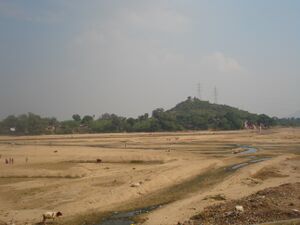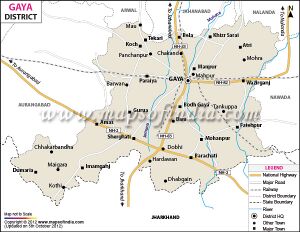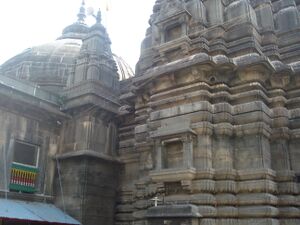Phalgu
| Author:Laxman Burdak, IFS (R) |
Phalgu (फल्गु नदी), a river that flows past Gaya, India in the Indian state of Bihar, is a sacred river for Hindus and Buddhists. Lord Vishnu's Temple Vishnupad Mandir is situated on the bank of Phalgu river.
Contents
Variants
- Phalgu River फल्गु नदी, बिहार, (AS, p.597)
- Phalgu river
- Falgu/Falgu River फल्गु नदी
- Falgu River फल्गु, बिहार, (AS, p.597)
Course
The Phalgu is formed by the confluence, some 3 kms below Bodh Gaya, of the Lilajan (also called Niranjan or Nilanjan) and the Mohana, two large hill streams each of which is over 270 metres wide.[1] The Phalgu is also mentioned as Niranjan.[2] The united stream flows on to the north past the town of Gaya, where it attains a breadth of over 820 metres). The Phalgu here passes by a high rocky bank, on the steep sides of which are many paved stairs leading down to the river bed, while high above are the Vishnupad Mandir, with many minor shrines around it. It then runs in a north-easterly direction for about 27 kms, and opposite the Barabar hills it again takes the name of Mohana, and divides into two branches which eventually flow into a branch of the Punpun.[3]
The Phalgu like its confluent streams, Lilajan and Mohana, is subject to high floods during the monsoons but in other seasons of the year it dwindles to a stream wandering through a wide expanse of sand.[4]
History
In Mahabharata
Falgu River (फल्गु) is mentioned in (III.82.86), (III.85.9)
Vana Parva, Mahabharata/Book III Chapter 82 mentions names Pilgrims. Falgu River (फल्गु) is mentioned in (III.82.86).[5].... The person that stayeth at Gaya during both the dark and lighted fortnights, certainly sanctifieth, O king, his own race up and down to the seventh generation. One should wish for many sons so that even one may go to Gaya, or celebrate the horse-sacrifice, or offer a nila bull. Then, O king, the pilgrim should proceed to Phalgu (फल्गु) (III.82.86). By this, he obtains the merit of horse-sacrifice, and acquires great success.
Vana Parva, Mahabharata/Book III Chapter 85 mentions sacred asylums, tirthas, mountans and regions of eastern country. Falgu River (फल्गु) is mentioned in (III.85.9).[6].....t is for this that the ancients say that one should wish for many sons, so that even one among them may visit Gaya (गय) (III.85.8), celebrate the horse-sacrifice or give away a nila bull, and thereby deliver ten generations of his race up and down. There, O monarch, is a great river, and spot called Gayashira (गय शिर) (III.85.8). In Gayasira is a banian, which is called by the Brahmanas the Akshayavata (अक्षय वटः) (III.85.8), the Eternal banian, for the food that is offered there to the Pitris becometh eternal, O exalted one! The great river that floweth by the place is known by the name of Phalgu (फल्गु) (III.85.9), and its waters are all sacred.
फल्गु नदी
विजयेन्द्र कुमार माथुर[7] ने लेख किया है ...फल्गु नदी (AS, p.597) गया के निकट बहने वाली नदी जो पुराणों में प्रसिद्ध है. महाभारत में [p.598]: गया के वर्णन के प्रसंग में शायद इसी नदी का निर्देश निम्न रूप में है-- 'नगोगयशिरोयत्र पुण्या चैव महानदी, वानीरमालिनी रम्या नदी पुलिन शोभिता'--वनपर्व 95,9-10; 'महानदी च तत्रैव तथागयशिरॊ नृप'---वनपर्व 88,11. यह संभव है कि यहाँ 'महानदी' शब्द फल्गु के एक पर्याय या नाम के रूप में ही प्रयुक्त हुआ है न कि विशेषण के रूप में. यह तथ्य ध्यान देने योग्य है की फल्गु का एक स्थानीय नाम आज भी महाना है जो अवश्य ही महानदी का अपभ्रंश है. गया से 3 मील दूर महाना अथवा फल्गु में नीलांजना नाम की छोटी सी नदी मिलती है जो बौद्ध साहित्य की निरंजना है.
फल्गु नदी परिचय
फल्गु नदी: छोटा नागपुर पठार के उत्तरी भाग से निकलती है। यह नदी झारखण्ड राज्य की एक प्रमुख नदी है। अनेक छोटी-छोटी सरिताओं के मिलने से इस नदी की मुख्य धारा का निर्माण होता है। मुख्य धारा का नाम 'निरंजना' या 'लिलाजन' है। बोध गया के पास मोहना नामक सहायक नदी से मिलकर यह विशाल रूप धारण कर लेती है। गया के निकट इसकी चौड़ाई सर्वाधिक होती है।
प्रसिद्ध नदी तीर्थ: पितृपक्ष के समय देश के विभिन्न भागों से लोग फल्गु नदी में स्नान के लिए आते हैं और पिण्डदान करते हैं। आचार्य बुद्धघोष के अनुसार प्राचीन समय में गया एक घाट (तित्थ) और गाँव दोनों था। प्रतिवर्ष 'फग्गुण' (फाल्गुन) मास में कृष्णपक्ष में गया के फग्गुणी घाट पर मेला जुड़ता था। इस मेले में सेनक थेर (श्रेणिक स्थविर) को भगवान बुद्ध ने बौद्ध धर्म में दीक्षित किया था। बोध गया से छह-सात मील की दूरी पर फल्गु नदी है। भगवान यहाँ विचरण कर चुके थे।
विद्वान् मान्यता: 'नेरंजरा' (बुद्ध गया के पास प्रवाहित होने वाली वर्तमान नीलाजन) नदी बुद्ध गया के कुछ ऊपर चलकर मोहना नदी में मिलती है और दोनों मिलकर फल्गु नदी कहलाती हैं। कुछ विद्वान् नेरंजरा को ही फल्गु मानते हैं। भगवान ने इस जगह उरुवेला में 6 वर्ष तप किया, उसके बाद में कई बार विहार किया था। संयुत्त निकाय के कई सुत्तों में नेरंजरा के तट पर भगवान ने जो उपदेश दिए उनका वर्णन है। यहाँ का जल, मिट्टी अत्यन्त ही पवित्र मानी गई है, क्योंकि भगवान के चरणों ने इसे स्पर्श कर पावन बनाया। (बु.भा.भू., पृ. 135, 218)
संदर्भ: भारतकोश-फल्गु नदी
External links
References
- ↑ "Bengal District Gazaetter - Gaya By L.S.S. O'malley". pp. 8-9. Google books.
- ↑ "Gaya, India".
- ↑ "Bengal District Gazaetter - Gaya By L.S.S. O'malley". pp. 8-9. Google books.
- ↑ "Bengal District Gazaetter - Gaya By L.S.S. O'malley". pp. 8-9. Google books.
- ↑ ततः फल्गुं वरजेद राजंस तीर्थसेवी नराधिप, अश्वमेधम अवाप्नॊति सिद्धिं च महतीं वरजेत (III.82.86)
- ↑ सा च पुण्यजला यत्र फल्गु नामा महानदी, बहुमूलफला चापि कौशिकी भरतर्षभ, विश्वा मित्रॊ ऽभयगाद यत्र बराह्मणत्वं तपॊधनः (III.85.9)
- ↑ Aitihasik Sthanavali by Vijayendra Kumar Mathur, p.597-598
Back to Rivers


